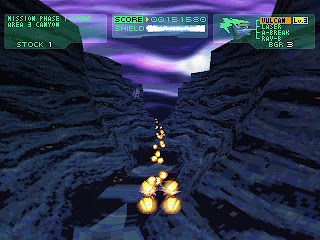Retro gaming nostalgia has some odd blind spots -- everyone remembers minor 16-bit shooters like Axelay and Truxton, but the early 32-bit shooters don't get much press. I was in the mood for a little rapid-fire shmup action, and so I dug out my copy of Philosoma. (My armchair etymology translates this as "Love Body," or "Body Love," which sounds like a different sort of game altogether -- I think it has something to do with an alien biological threat, as implied by the opening movie.)
Philosoma was an early Playstation shoot-'em-up released by Sony Computer Entertainment of America; it didn't quite make the launch window, but was clearly intended to round out the fledgling system's library. A non-interactive movie promoting the game was included on the demo disc packed in with the first batch of US Playstations, and my copy was released in the cardboard longbox packaging used for some of the system's early releases, after the initial Saturn-style plastic cases but before the switch to a standard CD form factor. It sports a BEST SHOOTER OF THE YEAR blurb on the cover, but that's from an EGM Buyers Guide rather than an actual review, so take it with a grain of salt.
Philosoma is a typical launch game, indicative of the challenges and opportunities Sony faced as it came from behind to lead the industry's charge into 32-bit, CD-based gaming. When technology generations are turning over, the launch games almost always try to do what the previous generation did, "only better." In this case, Sony opted to design a traditional shooter, jazzing it up with 3-D elements augmented by extensive CG animation sequences and voice acting.
The visual approach tries to provide a seamless transition between pre-rendered CG and in-game visuals, but while the camera angles are consistent, the look shifts jarringly between smooth MPEG animation and texture-mapped polygons and sprites. (Note that these screenshots were gathered using the ePSXe emulator, so the polygons are rendered at higher resolution than on the actual original PSX. The sprites and HUD are displayed more-or-less accurately, which is useful here for emphasis.)
The game isn't nearly in full 3-D -- the first-generation Playstation hardware was capable enough, but the design specs were likely being finalized while this title was in development. The designers opted to play it safe, perhaps so pre-rendered backgrounds could be used if the polygon performance wasn't up to scratch. The enemy ships and bullets are all handled as sprites, and only the backgrounds are modeled in 3-D. In fact, during the final boss battle section the game switches completely to 2-D, with flat parallax-scrolling backgrounds and nary a polygon in sight, probably because the side-on perspective would have made draw distance a problem in the far background.
Philosoma also abuses the whole concept of 3-D to show off the Playstation's capabilities. The first level ("Phase 1" in the game's parlance) sends the player flying through a repetitively-textured gray canyon, shooting at floating rocks and several types of alien craft. The gameplay itself doesn't really change, although the difficulty ramps up with more complicated and powerful enemies as the stage progresses. But the perspective keeps shifting around, just to show that it can be done.
We start Phase 1 in traditional top-down 2-D shooter style. as shown above. Then the camera flips around to a bottom-up 2-D shooter style, that is, from a viewpoint looking up at the bottom of our ship. The gameplay doesn't really change at all -- fortunately, the controls aren't reversed -- and it comes off as an ostentatious "innovation" that has utterly failed to influence later generations of shooter design:
Then the perpsective shifts again, and we're playing Astron Belt, essentially, with the player flying through the canyon on rails, shooting at the same types of enemies and dodging their fire in 3-D:
Then, maddeningly, we're stuck out in FRONT of our ship, trying to avoid enemy fire and using our limited stock of smart bombs to survive, as we have no way of firing to the rear or predicting impending collisions with the landscape:
The final stretch switches to a side-on 2-D perspective, where we fight enemy sprites of various types until we take on the awkwardly-translated boss, Doggie House:
Phase 2 starts off by demonstrating the system's sprite scaling and rotation capabilities with an annoying zoomed-in perspective -- the game can't quite fit our fighter, the enemy ships and everyone's shots onscreen, so we end up taking a lot of damage from enemy fire that can't quite be seen in time to react:
At last the camera pulls back a bit so we can see what we're doing, and then we're flying over a Mag Max-style plane, showing off textures in perspective while we try in vain to line up a shot with the enemy sprites scattered randomly around the battleship's surface.
Then, to our dismay, we're stuck out in FRONT of the action again, dodging a barrage of enemy missiles and ramming attacks from behind:
And so it goes. Philosoma is a competent and challenging shooter as far as the action goes, and much of the artwork is quite lovely. But it's a launch title and the time pressure shows; with historical hindsight, it's clear that it's not very fresh or imaginative. Philosoma at its best when it sticks to 2-D, with a nice Thunder Force vibe, and at its least engaging when it succumbs to the urge to use all the new PSX technology to no real purpose.











No comments:
Post a Comment